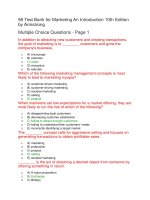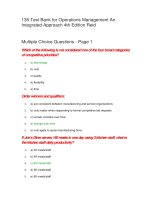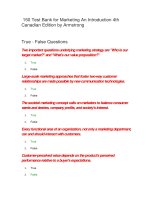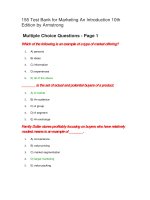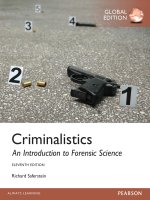2 operations research an INtroduction 10th global edition by taha
Bạn đang xem bản rút gọn của tài liệu. Xem và tải ngay bản đầy đủ của tài liệu tại đây (9.85 MB, 849 trang )
Operations Research
An Introduction
This page intentionally left blank
Operations Research
An Introduction
Tenth Edition
Global Edition
Hamdy A. Taha
University of Arkansas, Fayetteville
Harlow, England • London • New York • Boston • San Francisco • Toronto • Sydney • Dubai • Singapore • Hong Kong
Tokyo • Seoul • Taipei • New Delhi • Cape Town • Sao Paulo • Mexico City • Madrid • Amsterdam • Munich • Paris • Milan
VP/Editorial Director, Engineering/
Computer Science: Marcia J. Horton
Editor in Chief: Julian Partridge
Executive Editor: Holly Stark
Editorial Assistant: Amanda Brands
Assistant Acquisitions Editor,
Global Edition: Aditee Agarwal
Project Editor, Global Edition:
Radhika Raheja
Field Marketing Manager: Demetrius Hall
Marketing Assistant: Jon Bryant
Team Lead, Program Management:
Scott Disanno
Program Manager: Erin Ault
Director of Operations: Nick Sklitsis
Operations Specialist: Maura Zaldivar-Garcia
Cover Designer: Lumina Datamatics
Media Production Manager, Global Edition:
Vikram Kumar
Senior Manufacturing Controller, Global Edition:
Angela Hawksbee
Full-Service Project Management: Integra Software
Services Pvt. Ltd
Cover Photo Credit: © Lightspring/Shutterstock
Pearson Education Limited
Edinburgh Gate
Harlow
Essex CM20 2JE
England
and Associated Companies throughout the world
Visit us on the World Wide Web at:
www.pearsonglobaleditions.com
© Pearson Education Limited 2017
The rights of Hamdy A. Taha to be identified as the author of this work have been asserted by him in
accordance with the Copyright, Designs and Patents Act 1988.
Authorized adaptation from the United States edition, Operations Research An Introduction, 10th edition,
ISBN 9780134444017, by Hamdy A. Taha published by Pearson Education © 2017.
All rights reserved. No part of this publication may be reproduced, stored in a retrieval system, or
transmitted in any form or by any means, electronic, mechanical, photocopying, recording or otherwise,
without either the prior written permission of the publisher or a license permitting restricted copying in the
United Kingdom issued by the Copyright Licensing Agency Ltd, Saffron House, 6–10 Kirby Street, London
EC1N 8TS.
All trademarks used herein are the property of their respective owners. The use of any trademark in this
text does not vest in the author or publisher any trademark ownership rights in such trademarks, nor does
the use of such trademarks imply any affiliation with or endorsement of this book by such owners.
British Library Cataloguing-in-Publication Data
A catalogue record for this book is available from the British Library
10 9 8 7 6 5 4 3 2 1
ISBN 10: 1-292-16554-5
ISBN 13: 978-1-292-16554-7
Typeset in 10/12 Times Ten LT Std by Integra Software Services Private Ltd.
Printed and bound in Malaysia
To Karen
Los ríos no llevan agua,
el sol las fuentes secó . . .
¡Yo sé donde hay una fuente
que no ha de secar el sol!
La fuente que no se agota
es mi propio corazón . . .
—V. Ruiz Aguilera (1862)
This page intentionally left blank
Contents
What’s New in the Tenth Edition
Acknowledgments
About the Author
Trademarks
Chapter 1
27
29
31
31
1.1
Introduction
1.2
Operations Research Models
1.3
Solving the OR Model
1.4
Queuing and Simulation Models
1.5
Art of Modeling
1.6
More than Just Mathematics
1.7
Phases of an OR Study
1.8
About this Book
Bibliography
Chapter 2
25
What Is Operations Research?
Problems
23
31
34
35
36
37
39
41
41
42
Modeling with Linear Programming
45
45
47
2.1
Two-Variable LP Model
2.2
Graphical LP Solution
2.2.1 Solution of a Maximization Model 48
2.2.2 Solution of a Minimization Model 50
2.3
Computer Solution with Solver and AMPL
2.3.1 LP Solution with Excel Solver 52
2.3.2 LP Solution with AMPL 56
2.4
Linear Programming Applications 59
2.4.1 Investment 60
2.4.2 Production Planning and Inventory Control
2.4.3 Workforce Planning 67
2.4.4 Urban Development Planning 70
2.4.5 Blending and Refining 73
2.4.6 Additional LP Applications 76
Bibliography
Problems
52
62
76
76
7
8
Contents
Chapter 3
The Simplex Method and Sensitivity Analysis
99
3.1
LP Model in Equation Form
3.2
Transition from Graphical to Algebraic Solution
3.3
The Simplex Method 103
3.3.1 Iterative Nature of the Simplex Method 103
3.3.2 Computational Details of the Simplex Algorithm
3.3.3 Summary of the Simplex Method 111
100
105
3.4
Artificial Starting Solution 112
3.4.1 M-Method 112
3.4.2 Two-Phase Method 115
3.5
Special Cases in the Simplex Method
3.5.1 Degeneracy 118
3.5.2 Alternative Optima 119
3.5.3 Unbounded Solution 121
3.5.4 Infeasible Solution 122
3.6
Sensitivity Analysis 123
3.6.1 Graphical Sensitivity Analysis 124
3.6.2 Algebraic Sensitivity Analysis—Changes in the
Right-Hand Side 128
3.6.3 Algebraic Sensitivity Analysis—Objective Function
3.6.4 Sensitivity Analysis with TORA, Solver,
and AMPL 136
3.7
117
Computational Issues in Linear Programming
Bibliography
Problems
132
138
142
Case Study: Optimization of Heart Valves Production
Chapter 4
99
142
145
Duality and Post-Optimal Analysis
169
169
4.1
Definition of the Dual Problem
4.2
Primal–Dual Relationships 172
4.2.1 Review of Simple Matrix Operations 172
4.2.2 Simplex Tableau Layout 173
4.2.3 Optimal Dual Solution 174
4.2.4 Simplex Tableau Computations 177
4.3
Economic Interpretation of Duality 178
4.3.1 Economic Interpretation of Dual Variables 179
4.3.2 Economic Interpretation of Dual Constraints 180
4.4
Additional Simplex Algorithms 182
4.4.1 Dual Simplex Algorithm 182
4.4.2 Generalized Simplex Algorithm
184
Contents
4.5
Post-Optimal Analysis 185
4.5.1 Changes Affecting Feasibility 186
4.5.2 Changes Affecting Optimality 189
192
Problems 192
Bibliography
Chapter 5
Transportation Model and Its Variants
207
207
211
5.1
Definition of the Transportation Model
5.2
Nontraditional Transportation Models
5.3
The Transportation Algorithm 214
5.3.1 Determination of the Starting Solution 216
5.3.2 Iterative Computations of the Transportation
Algorithm 220
5.3.3 Simplex Method Explanation of the Method of
Multipliers 226
5.4
The Assignment Model 227
5.4.1 The Hungarian Method 227
5.4.2 Simplex Explanation of the Hungarian Method
Bibliography 231
230
Case Study: Scheduling Appointments at Australian
Tourist Commission Trade Events 232
Problems 236
Chapter 6
Network Model
247
247
6.1
Scope and Definition of Network Models
6.2
Minimal Spanning Tree Algorithm
6.3
Shortest-Route Problem 251
6.3.1 Examples of the Shortest-Route Applications
6.3.2 Shortest-Route Algorithms 255
6.3.3 Linear Programming Formulation of the
Shortest-Route Problem 261
250
6.4
Maximal Flow Model 265
6.4.1 Enumeration of Cuts 266
6.4.2 Maximal Flow Algorithm 267
6.4.3 Linear Programming Formulation of Maximal
Flow Mode 272
6.5
CPM and PERT 273
6.5.1 Network Representation 274
6.5.2 Critical Path Method (CPM) Computations
6.5.3 Construction of the Time Schedule 279
252
276
9
10
Contents
6.5.4 Linear Programming Formulation of CPM
6.5.5 PERT Networks 283
Bibliography
285
Case Study: Saving Federal Travel Dollars
Problems 289
Chapter 7
282
Advanced Linear Programming
286
305
7.1
Simplex Method Fundamentals 305
7.1.1 From Extreme Points to Basic Solutions 306
7.1.2 Generalized Simplex Tableau in Matrix Form 309
7.2
Revised Simplex Method 311
7.2.1 Development of the Optimality and Feasibility
Conditions 311
7.2.2 Revised Simplex Algorithm 312
7.2.3 Computational Issues in the Revised Simplex
Method 315
7.3
Bounded-Variables Algorithm
7.4
Duality 322
7.4.1 Matrix Definition of the Dual Problem
7.4.2 Optimal Dual Solution 322
317
7.5
Parametric Linear Programming 325
7.5.1 Parametric Changes in C 325
7.5.2 Parametric Changes in b 327
7.6
More Linear Programming Topics
322
329
330
330
Bibliography
Problems
Chapter 8
Goal Programming
8.1
8.2
341
341
Goal Programming Algorithms 343
8.2.1 The Weights Method 343
8.2.2 The Preemptive Method 345
Bibliography 350
A Goal Programming Formulation
Case Study: Allocation of Operating Room Time in
Mount Sinai Hospital 350
Problems
Chapter 9
354
Integer Linear Programming
9.1
359
Illustrative Applications 359
9.1.1 Capital Budgeting 360
9.1.2 Set-Covering Problem 361
Contents
9.1.3 Fixed-Charge Problem 362
9.1.4 Either-Or and If-Then Constraints
9.2
364
Integer Programming Algorithms 366
9.2.1 Branch-and-Bound (B&B) Algorithm
9.2.2 Cutting-Plane Algorithm 373
367
378
379
Bibliography
Problems
Chapter 10
Heuristic Programming
10.1 Introduction
397
397
10.2 Greedy (Local Search) Heuristics 398
10.2.1 Discrete Variable Heuristic 399
10.2.2 Continuous Variable Heuristic 401
10.3 Metaheuristic 404
10.3.1 Tabu Search Algorithm 404
Summary of Tabu Search Algorithm 408
10.3.2 Simulated Annealing Algorithm 408
Summary of Simulated Annealing Algorithm 410
10.3.3 Genetic Algorithm 411
Summary of Genetic Algorithm 414
10.4 Application of Metaheuristics to Integer Linear
Programs 415
10.4.1 ILP Tabu Algorithm 416
10.4.2 ILP Simulated Annealing Algorithm 418
10.4.3 ILP Genetic Algorithm 420
10.5 Introduction to Constraint Programming (CP)
423
425
Problems 425
Bibliography
Chapter 11
Traveling Salesperson Problem (TSP)
11.1 Scope of the TSP
435
435
437
11.3 Exact TSP Algorithms 441
11.3.1 B&B Algorithm 441
11.2 TSP Mathematical Model
11.3.2 Cutting-Plane Algorithm
444
11.4 Local Search Heuristics 445
11.4.1 Nearest-Neighbor Heuristic
11.4.2 Reversal Heuristic 446
445
11.5 Metaheuristics 449
11.5.1 TSP Tabu Algorithm 449
11.5.2 TSP Simulated Annealing Algorithm
452
11
12
Contents
11.5.3 TSP Genetic Algorithm
454
458
Problems 458
Bibliography
Chapter 12
Deterministic Dynamic Programming
469
12.1 Recursive Nature of Dynamic Programming (DP)
Computations 469
12.2 Forward and Backward Recursion
473
12.3 Selected DP Applications 474
12.3.1 Knapsack/Fly-Away Kit/Cargo-Loading
Model 475
12.3.2 Workforce Size Model 480
12.3.3 Equipment Replacement Model 482
12.3.4 Investment Model 485
12.3.5 Inventory Models 488
12.4 Problem of Dimensionality
Bibliography
488
490
Case Study: Optimization of Crosscutting and
Log Allocation at Weyerhaeuser 491
Problems
Chapter 13
494
Inventory Modeling (with Introduction
to Supply Chains) 501
13.1 Inventory Problem: A Supply Chain Perspective 501
13.1.1 An Inventory Metric in Supply Chains 502
13.1.2 Elements of the Inventory Optimization
Model 504
13.2 Role of Demand in the Development of
Inventory Models 505
13.3 Static Economic-Order-Quantity Models 507
13.3.1 Classical EOQ Model 507
13.3.2 EOQ with Price Breaks 511
13.3.3 Multi-Item EOQ with Storage Limitation
514
13.4 Dynamic EOQ Models 517
13.4.1 No-Setup EOQ Model 518
13.4.2 Setup EOQ Model 521
13.5 Sticky Issues in Inventory Modeling
Bibliography
530
531
Case Study: Kroger Improves Pharmacy Inventory
Management 531
Problems
535
Contents
Chapter 14
Review of Basic Probability
543
14.1 Laws of Probability 543
14.1.1 Addition Law of Probability 544
14.1.2 Conditional Law of Probability 544
14.2 Random Variables and Probability Distributions
545
14.3 Expectation of a Random Variable 547
14.3.1 Mean and Variance (Standard Deviation)
of a Random Variable 547
14.3.2 Joint Random Variables 548
14.4 Four Common Probability Distributions 551
14.4.1 Binomial Distribution 551
14.4.2 Poisson Distribution 551
14.4.3 Negative Exponential Distribution 552
14.4.4 Normal Distribution 553
14.5 Empirical Distributions
555
560
560
Bibliography
Problems
Chapter 15
Decision Analysis and Games
567
15.1 Decision Making Under Certainty—Analytic
Hierarchy Process (AHP) 567
15.2 Decision Making Under Risk 574
15.2.1 Decision Tree–Based Expected Value Criterion 574
15.2.2 Variants of the Expected Value Criterion 576
15.3 Decision Under Uncertainty
581
15.4 Game Theory 585
15.4.1 Optimal Solution of Two-Person Zero-Sum
Games 585
15.4.2 Solution of Mixed Strategy Games 587
Bibliography
592
Case Study: Booking Limits in Hotel Reservations
Problems
Chapter 16
595
Probabilistic Inventory Models
611
16.1 Continuous Review Models 611
16.1.1 “Probabilitized” EOQ Model 611
16.1.2 Probabilistic EOQ Model 613
16.2 Single-Period Models 617
16.2.1 No-Setup Model (Newsvendor Model)
16.2.2 Setup Model (s-S Policy) 620
618
593
13
14
Contents
16.3 Multiperiod Model
623
625
Problems 625
Bibliography
Chapter 17
Markov Chains
629
17.1 Definition of a Markov Chain
629
17.2 Absolute and n-Step Transition Probabilities
632
17.3 Classification of the States in a Markov
Chain 633
17.4 Steady-State Probabilities and Mean Return Times
of Ergodic Chains 634
17.5 First Passage Time
636
17.6 Analysis of Absorbing States
639
642
642
Bibliography
Problems
Chapter 18
Queuing Systems
653
18.1 Why Study Queues?
653
18.2 Elements of a Queuing Model
654
656
18.3 Role of Exponential Distribution
18.4 Pure Birth and Death Models (Relationship Between
the Exponential and Poisson Distributions) 657
18.4.1 Pure Birth Model 658
18.4.2 Pure Death Model 661
18.5 General Poisson Queuing Model
662
18.6 Specialized Poisson Queues 665
18.6.1 Steady-State Measures of Performance
18.6.2 Single-Server Models 670
18.6.3 Multiple-Server Models 674
18.6.4 Machine Servicing Model—(M/M/R):
(GD/K/K), R 6 K 680
18.7 (M/G/1):(GD/H/H)—Pollaczek-Khintchine (P-K)
Formula 682
683
18.9 Queuing Decision Models 684
18.9.1 Cost Models 684
18.8 Other Queuing Models
18.9.2 Aspiration Level Model
Bibliography
688
686
667
Contents
Case Study: Analysis of an Internal Transport System
in a Manufacturing Plant 688
Problems
Chapter 19
690
Simulation Modeling
711
19.1 Monte Carlo Simulation 711
19.2 Types of Simulation 715
19.3 Elements of Discrete Event Simulation 715
19.3.1 Generic Definition of Events 715
19.3.2 Sampling from Probability Distributions 716
19.4 Generation of Random Numbers 720
19.5 Mechanics of Discrete Simulation 722
19.5.1 Manual Simulation of a Single-Server Model 722
19.5.2 Spreadsheet-Based Simulation
of the Single-Server Model 726
19.6 Methods for Gathering Statistical Observations 728
19.6.1 Subinterval Method 729
19.6.2 Replication Method 730
19.7 Simulation Languages 731
733
733
Bibliography
Problems
Chapter 20
Classical Optimization Theory
741
20.1 Unconstrained Problems 741
20.1.1 Necessary and Sufficient Conditions 742
20.1.2 The Newton-Raphson Method 744
20.2 Constrained Problems 746
20.2.1 Equality Constraints 747
20.2.2 Inequality Constraints—Karush–Kuhn–Tucker (KKT)
Conditions 754
Bibliography 758
Problems 758
Chapter 21
Nonlinear Programming Algorithms
21.1 Unconstrained Algorithms 763
21.1.1 Direct Search Method 763
21.1.2 Gradient Method 766
21.2 Constrained Algorithms 769
21.2.1 Separable Programming 770
21.2.2 Quadratic Programming 777
763
15
16
Contents
21.2.3 Chance-Constrained Programming 781
21.2.4 Linear Combinations Method 785
21.2.5 SUMT Algorithm 787
Bibliography 788
Problems 788
Appendix A Statistical Tables
793
Appendix B Partial Answers to Selected Problems
Index 833
797
Available on the Companion
Website ( />Chapter 22
Additional Network and LP Algorithms 22.1
22.1 Minimum-Cost Capacitated Flow Problem 22.1
22.1.1 Network Representation 22.1
22.1.2 Linear Programming Formulation 22.2
22.1.3 Capacitated Network Simplex Algorithm 22.6
22.2 Decomposition Algorithm
22.13
22.3 Karmarkar Interior-Point Method 22.21
22.3.1 Basic Idea of the Interior-Point Algorithm
22.3.2 Interior-Point Algorithm 22.22
22.21
22.31
22.31
Bibliography
Problems
Chapter 23
Forecasting Models 23.1
23.1
23.3
23.1 Moving Average Technique
23.2 Exponential Smoothing
23.4
Bibliography 23.8
Problems 23.8
23.3 Regression
Chapter 24
Probabilistic Dynamic Programming 24.1
24.1 A Game of Chance
24.2 Investment Problem
24.1
24.3
24.3 Maximization of the Event of Achieving a Goal
24.6
24.9
Problems 24.9
Bibliography
Chapter 25
Markovian Decision Process 25.1
25.1
25.2 Finite-Stage Dynamic Programming Model 25.2
25.2.1 Exhaustive Enumeration Method 25.5
25.1 Scope of the Markovian Decision Problem
25.2.2 Policy Iteration Method without Discounting 25.8
25.2.3 Policy Iteration Method with Discounting 25.11
17
18
Available on the Companion Website
25.3 Linear Programming Solution
25.13
25.17
Problems 25.17
Bibliography
Chapter 26
Case Analysis 26.1
Case 1:
Airline Fuel Allocation Using Optimum Tankering
Case 2:
Optimization of Heart Valves Production
Case 3:
Scheduling Appointments at Australian Tourist
Commission Trade Events 26.13
Case 4:
Saving Federal Travel Dollars
Case 5:
Optimal Ship Routing and Personnel Assignment
for Naval Recruitment in Thailand 26.21
Case 6:
Allocation of Operating Room Time in Mount Sinai
Hospital 26.29
Case 7:
Optimizing Trailer Payloads at PFG Building Glass
Case 8:
Optimization of Crosscutting and Log Allocation
at Weyerhaeuser 26.41
Case 9:
Layout Planning for a Computer Integrated
Manufacturing (CIM) Facility 26.45
26.17
Case 10: Booking Limits in Hotel Reservations
26.53
Case 11: Casey’s Problem: Interpreting and Evaluating
a New Test 26.56
Case 12: Ordering Golfers on the Final Day of Ryder
Cup Matches 26.59
Case 13: Kroger Improves Pharmacy Inventory
Management 26.61
Case 14: Inventory Decisions in Dell’s Supply Chain
26.65
Case 15: Forest Cover Change Prediction Using Markov
Chain Model: A Case Study on Sub-Himalayan
Town Gangtok, India 26.69
Case 16: Analysis of an Internal Transport System
in a Manufacturing Plant 26.72
Case 17: Telephone Sales Workforce Planning
at Qantas Airways 26.74
Appendix C AMPL Modeling Language C.1
C.1
C.2 Components of AMPL Model C.2
C.1 Rudimentary AMPL Model
C.3 Mathematical Expressions and Computed
Parameters C.9
C.4 Subsets and Indexed Sets
C.12
26.2
26.9
26.33
Available on the Companion Website
C.13
C.20
C.5
Accessing External Files
C.6
Interactive Commands
C.7
Iterative and Conditional Execution of AMPL
Commands C.22
C.8
Sensitivity Analysis using AMPL
C.9
Selected AMPL Models
C.23
C.23
Bibliography C.36
Problems C.36
Appendix D Review of Vectors and Matrices
D.1
D.1
D.2 Matrices D.2
D.1 Vectors
D.3 Quadratic Forms
D.14
D.4 Convex and Concave Functions
Selected References D.15
Problems
Appendix E Case Studies
D.16
E.1
D.15
19
This page intentionally left blank
List of Aha! Moments
Chapter 1:
Chapter 3:
Chapter 5:
Chapter 6:
Chapter 7:
Chapter 8:
Chapter 9:
Chapter 10:
Chapter 11:
Chapter 12:
Chapter 13:
Chapter 14:
Chapter 15:
Chapter 17:
Chapter 18:
Chapter 19:
Ada Lovelace, the First-Ever Algorithm Programmer. (p. 35)
The Birth of Optimization, or How Dantzig Developed
the Simplex Method. (p. 105)
A Brief History of the Transportation Model. (p. 211)
Looking at the Bright Side of Hand Computations: The Classical
Transportation Model! (p. 214)
By Whatever Name, NW Rule Boasts Elegant Simplicity! (p. 219)
It is Said that a Picture is Worth a Thousand Words! (p. 250)
Early-On Implementations of the Simplex Algorithm, or How the
Use of the Product Form of the Inverse Came About. (p. 317)
Satisficing versus Maximizing, or How Long to Age Wine! (p. 344)
Seminal Development of Dantzig–Fulkerson–Johnson Cut. (p. 378)
Earliest Decision-Making Heuristic—The Franklin Rule. (p. 398)
Earliest Mathematical Model in Archaeology, or How to
“Seriate” Ancient Egyptian Graves Using TSP. (p. 436)
TSP Computational Experience, or How to Reproduce Leonardo
da Vinci’s Mona Lisa! (p. 448)
Solving Marriage Problem … with Dynamic Programming! (p. 472)
EOQ History, or Giving Credit Where Credit Is Due! (p. 510)
Teaching (Probability) by Example: The Birthday
Challenge! (p. 543)
Mark Twain Gives “Statistics” a Bum Wrap! (p. 559)
An Eighteenth-Century Lottery that Yields Infinite Expected
Payoff, or Does It? (p. 579)
Cooperation Should Be the Name of the Game! (p. 589)
Spammers Go Markovian! (p. 631)
Perception of Waiting, and the Cultural Factor! (p. 655)
The Last Will Be First…, or How to Move Queues More
Rapidly! (p. 666)
Retirement Planning Online: The Monte Carlo Way! (p. 713)
21
This page intentionally left blank
What’s New in the
Tenth Edition
Over the past few editions, I agonized over the benefit of continuing to include the
hand computational algorithms that, to my thinking, have been made obsolete by
present-day great advances in computing. I no longer have this “anxiety” because I
sought and received feedback from colleagues regarding this matter. The consensus is
that these classical algorithms must be preserved because they are an important part
of OR history. Some responses even included possible scenarios (now included in this
edition) in which these classical algorithms can be beneficial in practice.
In the spirit of my colleagues collective wisdom, which I now enthusiastically
espouse, I added throughout the book some 25 entries titled Aha! moments. These
entries, written mostly in an informal style, deal with OR anecdotes/stories (some
dating back to centuries ago) and OR concepts (theory, applications, computations,
and teaching methodology). The goal is to provide a historical perspective of the roots
of OR (and, hopefully, render a “less dry” book read).
Additional changes/additions in the tenth edition include:
• Using a brief introduction, inventory modeling is presented within the more
encompassing context of supply chains.
• New sections are added about computational issues in the simplex method
(Section 7.2.3) and in inventory (Section 13.5).
• This edition adds two new case analyses, resulting in a total of 17 fully developed
real-life applications. All the cases appear in Chapter 26 on the website and are
cross-referenced throughout the book using abstracts at the start of their most
applicable chapters. For convenience, a select number of these cases appear in the
printed book (I would have liked to move all the cases to their most applicable
chapters, but I am committed to limiting the number of hard-copy pages to less
than 900).
• By popular demand, all problems now appear at end of their respective chapters
and are cross-referenced by text section to facilitate making problem assignments.
• New problems have been added.
• TORA software has been updated.
23
This page intentionally left blank

